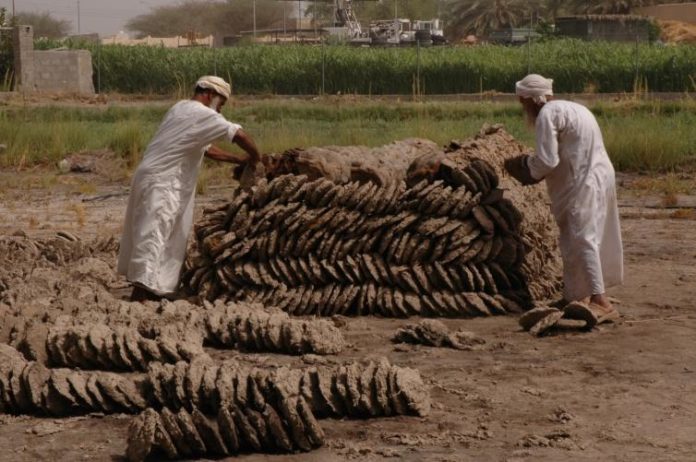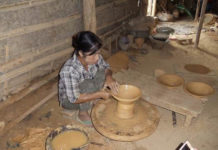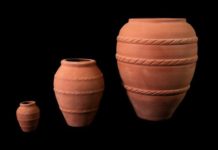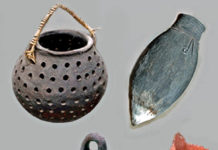Alsarooj is a kind of clay burnt at a certain temperature. It is produced from clay, which was originally used in construction works instead of cement. The alsarooj industry is known in Oman for a long time as it was used in the pre-Islamic eras in the construction of certain forts. It is also considered an important material in Omani architecture, as it can be found in old mosques, houses, forts and castles. It is produced by collecting soil from suitable places, purified and mixed until it becomes a consistent clay.
The stages of producing alsarooj start by preparing the area in which it will be placed. It is called al mahaba (made of the dry date palm trunks arranged in layers) with an area of 100 sq.m. Here, dried palm tree trunks are arranged to a height of 120 cm, and stones are inserted between the clay tablet valleys to strengthen the pile of palm trunks. Then, al mahaba is burned at a temperature of about 900°C. The burning process continues for two weeks, after which alsarooj will be ready to be transported to the required site. The production of alsarooj is explained in the following steps: (Public Authority of Crafts industries: 2014:211-213).

- Soil is collected from suitable places, purified and mixed until it becomes consistent clay. Such soil is preferred to be reddish and free of salts.
- The soil is soaked in pure, potable water for at least two weeks.
- The clay is then turned into circular tablets (diameter between 20 and 30 cm).
- The tablets are left to dry under the sun.
- After three days, the tablets are turned upwards and sideward to dry from all sides and be ready for burning.
In the burning process, the following steps are followed:
- Palm tree trunks are arranged in layers so that the second layer is opposite to the first layer.
- A number of vents are made at the bottom of al mahaba to allow the ignition of fire.
- The clay tablets are put on all sides.
- A quantity of hard stones (valley stones), proportionate to the quantity of clay are put on top of al mahaba to produce Al nora (gypsum) materials.
- Fire is ignited through the vents at the bottom of al mahaba.
- The clay tablets that fall during the burning process are returned back into al mahaba.
- At the end of the process, which is locally called al tasker (ventilation shut off), an amount of powder is formed.
- Then, alsarooj is compressed with a piece of wood called altafeel in order to be packed in bags after it cools down.





